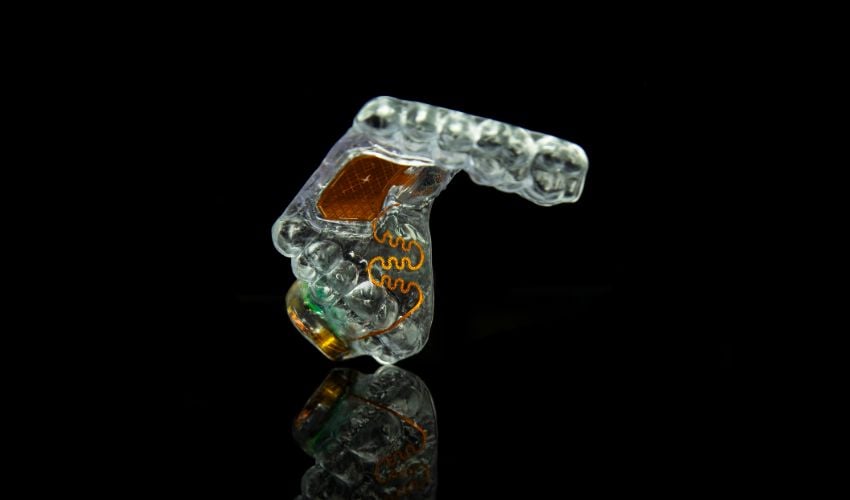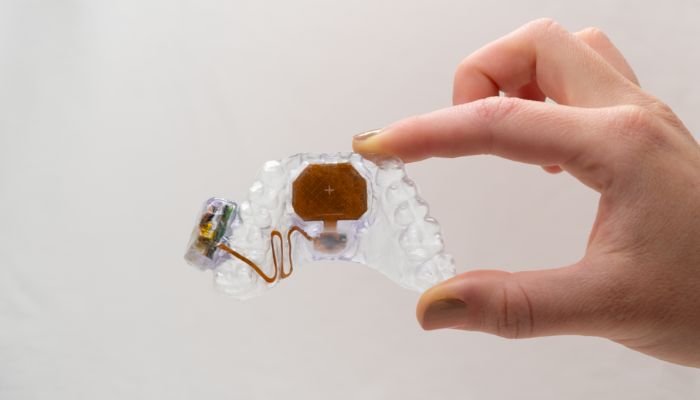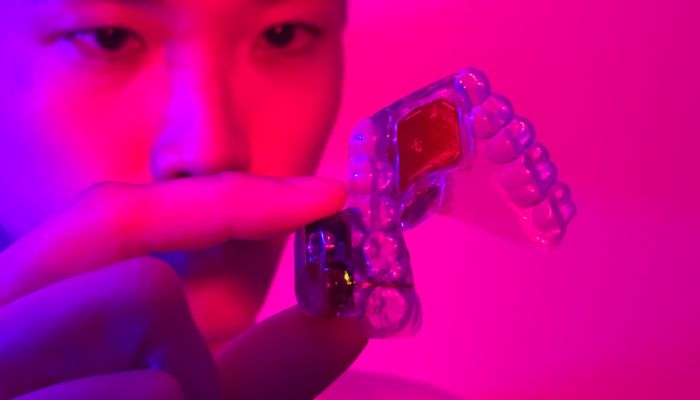#3DStartup: Augmental’s MouthPad^ Makes Technology More Accessible

What if it were possible to control a computer, tablet, or phone without moving a finger? For people with paralysis, Mouthpad^ from Augmental makes this a reality. The device sits discreetly on the roof of the mouth and converts subtle head or tongue gestures into mouse-like commands such as scrolling, clicking, and dragging on any device, with no software required. Users can speak normally while wearing it, and the device remains virtually invisible to others. Thanks to 3D printing, each Mouthpad^ is custom-made for comfort. Designed to make technology truly accessible, Mouthpad^ provides users with a new level of independence. We spoke with Co-founder and CEO Tomás Vega to learn about his inspiration for the company, the 3D printing technology behind the device, and upcoming projects.
1. Could you briefly introduce yourself and tell us how you first got involved with 3D printing?

Co-Founder and CEO of Augmental, Tomás Vega
My goal in life is to build cyborgs — humans that are augmented by technology. When I was 5 years old, I started stuttering, so a keyboard and a mouse became outlets for me to overcome my “limitations.” I became obsessed with technology. In high school, I worked with people with multiple sclerosis, and I further understood how fast one’s life can change. All of this led to me studying brains and computers in undergrad, with the goal of understanding how the brain and body work so I could probe them, hack them, and augment them. The human body and its operation is physical — we live in a physical world. In order to make devices that augment our abilities, I had to make systems that are physical. That led me to learn electronics and digital fabrication.
I joined a makerspace at Berkeley, the CITRIS Invention lab (where I learned a lot from Chris Myers!). I became a super user, which meant I had access 24/7. I learned to use laser cutters, 3D printers, CNC mills — my favorite was the LPKF S63. I was able to make double-sided PBCs in a matter of hours. I did a bunch of hackathons and won some competitions, and I got 3D printers as prizes. I had multiple 3D printers in my room, so I’d print everything I needed.
At the MIT Media Lab, I moved from FDM to SLA printers, made smaller electronics, learned micro-fabrication, and took the famous How to Make (Almost) Anything class. This expanded the mediums through which I could give shape to my ideas. That’s how I see 3D printers and other fabrication tools — they are mediums for us to physicalize our ideas.
2. How was Augmental founded, and what is its mission?
My friend Corten Singer and I launched Augmental in 2019 — in a basement in Somerville — after I finished my graduate work at MIT. I had met Corten at Berkeley, where we worked on a lot of assistive technology projects together, like WheelSense, a smart wheelchair. Over the pandemic, we relocated to San Francisco. With Seed funding, our company has grown to 10 full-time members — and we moved out of my garage last year.
Augmental’s mission is to augment human ability and enable more equitable access to the digital world.
3. Could you explain how MouthPad^ works? What is the user experience like?
The MouthPad^ functions like a standard mouse, but using tongue movements on the palate instead of a finger on a trackpad. The tongue-based trackpad is pressure sensitive, so it supports standard trackpad gestures such as swiping, scrolling, and click-and-drag. To left-click, the user taps their tongue lightly on the trackpad; to right-click, they perform a sipping gesture. The MouthPad^ also supports head-tracking, so users can customize their cursor control mode. We’ll be launching novel gestural interactions for shortcuts later this year.

MouthPad^ was 3D printed using SLA technology.
4. What technologies and materials do you use, and why?
We are using a capacitive trackpad that is able to precisely track the position of the tip of the tongue. Capacitive trackpads are usually noisy in wet environments (as you might know if you’ve tried to use your phone’s touchscreen when it’s raining) but our algorithms let us filter out that noise. The MouthPad^ also uses motion sensors for head-tracking. The Bluetooth-enabled microprocessor enables us to process the sensor data, make sense of it, map it to a BLE HID command, and transmit to any connected device (such as phones, tablets, and computers) as a standard input bluetooth device. It charges in its case using NFC charging.
For fabrication, we use intraoral 3D scanning, generative and parametric design, and SLA 3D printing with dental-grade resin. We use flexible and stretchable electronics in order to adapt to various mouth sizes.
5. What are your current biggest challenges?
The biggest challenge is building a company for social good — it’s challenging, because the market for solutions for people with disabilities is not considered significant by most investors. That has led us to have to go beyond our initial solution and make other products in order to fund the MouthPad^, which is changing lives. We are committed to serving our users and improving the MouthPad^ to provide the best technology possible, but we have to balance this with R&D for products for segments beyond disabilities that will allow us to continue existing.
6. There’s currently a waitlist to receive MouthPad^. What will distribution look like?
The MouthPad^ is currently for sale. We’re sending purchase invitations to the waitlist in batches to make sure we can prioritize devices for those who need the technology the most. We are scaling production and plan to open sales on the website by the end of this year.

MouthPad^ is designed for user comfort.
7. Do you have any plans for upcoming projects that you could share?
Yes, we’re current developing the next generation of the MouthPad^, called MouthPad^Whisper. With the original MouthPad^, we reinvented the computer mouse. Now, we are reinventing the keyboard. We are adding a low-volume microphone and moving from 2D to 3D tongue sensing to build a custom speech model, enabling private dictation (inaudible to someone next to you) that is robust to external noise.
We’re also working on devices outside of the mouth that use the same hardware and software infrastructure as the MouthPad^ and have similar purposes — to interact with computers with more bandwidth and minimal effort. It won’t be as expressive as the MouthPad^, of course, but will still grant users superpowers. Stay tuned!
8. Any final words for our readers?
Augmental is a human-machine interface company. The MouthPad^ is our flagship product. It’s the most expressive, non-invasive, commercially available input device. We will continue to improve it, miniaturize it, and add new capabilities, such as low-volume speech and fully silent speech to enable computing on the go. Humans shouldn’t be tethered to a seat or an office. Technology should meet humans where they are — not the other way around. To learn more about Augmental, visit the website HERE.
What do you think of Augmental? Let us know in a comment below or on our LinkedIn or Facebook pages! Plus, don’t forget to sign up for our free weekly Newsletter to get the latest 3D printing news straight to your inbox. You can also find all our videos on our YouTube channel.
*All Photo Credits: Augmental







